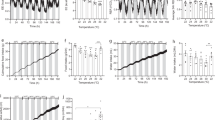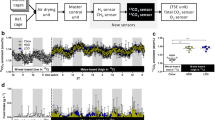Abstract
Objective:
To compare, in mice, the accuracy of estimates of energy expenditure (EE) using an energy balance technique (TEEbal: food energy intake and body composition change) vs indirect calorimetry (TEEIC).
Subjects:
In 32 male C57BL/6J mice, EE was estimated using an energy balance (caloric intake minus change in body energy stores) method over a 37-day period. EE was also measured in the same animals by indirect calorimetry. These measures were compared.
Results:
The two methods were highly correlated (r2=0.87: TEEbal=1.07*TEEIC–0.22, P<0.0001). By Bland–Altman analysis, TEEbal estimates were slightly higher (4.6±1.5%; P<0.05) than TEEIC estimates (Bias=0.55 kcal per 24 h).
Conclusion:
TEEbal can be performed in ‘home cages’ and provides an accurate integrated long-term measurement of EE while minimizing potentially confounding stress that may accompany the use of indirect calorimetry systems. The technique can also be used to assess long-term energy intake.
This is a preview of subscription content, access via your institution
Access options
Subscribe to this journal
Receive 12 print issues and online access
$259.00 per year
only $21.58 per issue
Buy this article
- Purchase on Springer Link
- Instant access to full article PDF
Prices may be subject to local taxes which are calculated during checkout

Similar content being viewed by others
Change history
12 March 2013
This article has been corrected since online publication and a corrigendum is also printed in this issue
References
Leibel RL, Rosenbaum M, Hirsch J . Changes in energy expenditure resulting from altered body weight. N Engl J Med 1995; 332: 621–628.
Yang MU, Wang J, Pierson RM, Van Itallie TB . Estimation of composition of weight loss in man: a comparison of methods. J Appl Physiol 1977; 43: 331–338.
de Jonge L, DeLany JP, Nguyen T, Howard J, Hadley EC, Redman LM et al. Validation study of energy expenditure and intake during calorie restriction using doubly labeled water and changes in body composition. Am J Clin Nutr 2007; 85: 73–79.
Gettys TW, Mills S, Henricks DM . An evaluation of the relation between food consumption rate and equilibrium body-weight in male rats. Br J Nutr 1988; 60: 151–160.
Guo J, Hall KD . Estimating the continuous-time dynamics of energy and fat metabolism in mice. PLoS Comput Biol 2009; 5: e1000511.
Arch JR, Hislop D, Wang SJ, Speakman JR . Some mathematical and technical issues in the measurement and interpretation of open-circuit indirect calorimetry in small animals. Int J Obes (Lond) 2006; 30: 1322–1331.
Ravussin Y, Gutman R, Diano S, Shanabrough M, Borok E, Sarman B et al. Effects of Chronic weight perturbation on energy homeostasis and brain structure in mice. Am J Physiol Regul Integr Comp Physiol 2011; 300: R1352–R1362.
Halldorsdottir S, Carmody J, Boozer C, LeDuc CA, Leibel RL . Reproducibility and Accuracy of Body composition assessments in mice by dual energy X-ray absorptiometry and time domain nuclear magnetic resonance. Int J Body Compos Res 2009; 7: 147–154.
Pullar JD, Webster AJ . The energy cost of fat and protein deposition in the rat. Br J Nutr 1977; 37: 355–363.
Schulz LO, Alger S, Harper I, Wilmore JH, Ravussin E . Energy expenditure of elite female runners measured by respiratory chamber and doubly labeled water. J Appl Physiol 1992; 72: 23–28.
Dutilleul P . Rythms and autocorrelation analysis. Biol Rhythm Res 1995; 26: 173–193.
Bland JM, Altman DG . Comparing methods of measurement: why plotting difference against standard method is misleading. Lancet 1995; 346: 1085–1087.
Bland JM, Altman DG . Statistical methods for assessing agreement between two methods of clinical measurement. Lancet 1986; 1: 307–310.
Apfelbaum M . Adaptation to changes in caloric intake. Prog Food Nutr Sci 1978; 2: 543–559.
Forsum E, Hillman PE, Nesheim MC . Effect of energy restriction on total heat production, basal metabolic rate, and specific dynamic action of food in rats. J Nutr 1981; 111: 1691–1697.
Rikke BA, Yerg JE, Battaglia ME, Nagy TR, Allison DB, Johnson TE . Strain variation in the response of body temperature to dietary restriction. Mech Ageing Dev 2003; 124: 663–678.
Surwit RS, Kuhn CM, Cochrane C, McCubbin JA, Feinglos MN . Diet-induced type II diabetes in C57BL/6J mice. Diabetes 1988; 37: 1163–1167.
Overton JM . Phenotyping small animals as models for the human metabolic syndrome: thermoneutrality matters. Int J Obes (Lond) 2010; 34 (Suppl 2): S53–S58.
Levine JA . Measurement of energy expenditure. Public Health Nutr 2005; 8: 1123–1132.
Schoeller DA . Limitations in the assessment of dietary energy intake by self-report. Metabolism 1995; 44 (2 Suppl 2): 18–22.
Rosenbaum M, Leibel RL . Adaptive thermogenesis in humans. Int J Obes (Lond) 2010; 34 (Suppl 1): S47–S55.
Thomas DM, Schoeller DA, Redman LA, Martin CK, Levine JA, Heymsfield SB . A computational model to determine energy intake during weight loss. Am J Clin Nutr 2010; 92: 1326–1331.
Acknowledgements
This work was supported by National Institutes of Health Grants RO1-DK-066518, P30-DK-026687, ADA 7-11-MN-34, and a research grant from AstraZeneca. We thank Dr Marc Reitman for comments on the manuscript.
Author information
Authors and Affiliations
Corresponding author
Ethics declarations
Competing interests
The authors declare no conflict of interest.
Rights and permissions
About this article
Cite this article
Ravussin, Y., Gutman, R., LeDuc, C. et al. Estimating energy expenditure in mice using an energy balance technique. Int J Obes 37, 399–403 (2013). https://doi.org/10.1038/ijo.2012.105
Received:
Revised:
Accepted:
Published:
Issue Date:
DOI: https://doi.org/10.1038/ijo.2012.105
Keywords
This article is cited by
-
Epigenetic regulation of white adipose tissue plasticity and energy metabolism by nucleosome binding HMGN proteins
Nature Communications (2022)
-
Maternal Roux-en-Y gastric bypass surgery reduces lipid deposition and increases UCP1 expression in the brown adipose tissue of male offspring
Scientific Reports (2021)
-
UCP1 governs liver extracellular succinate and inflammatory pathogenesis
Nature Metabolism (2021)
-
Accumulation of succinate controls activation of adipose tissue thermogenesis
Nature (2018)
-
Brs3 neurons in the mouse dorsomedial hypothalamus regulate body temperature, energy expenditure, and heart rate, but not food intake
Nature Neuroscience (2018)



